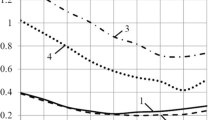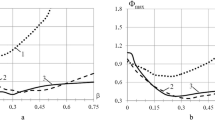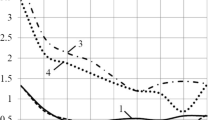The effect of contact conditions and the gap between the metal and composite layers on the stress-strain state and strength of a two-layer metal composite cylinder under internal explosive loading in air is numerically studied. It is accepted that in the absence of a gap between the metal and composite layers, there is no interference. The problem was considered on the basis of the general equations of theories of elasticity and plasticity in a one-dimensional formulation (plane strain state), which makes it possible to neglect the peculiarities of loading and deformation along the cylinder length. In the absence of an initial gap, the case of perfect contact between the layers was also studied. The inner layer is made of one or another isotropic elastoplastic steel with significantly different yield strengths (steels 20 and 40KhNMA), the outer one is made of an elastic-to-failure cylindrically transtropic circumferentially reinforced composite The dynamic 1D boundary-value problem was solved using the training version of the LS-DYNA software, which is part of the ANSYS commercial application package. The solution method is the Wilkins finitedifference integro-interpolation algorithm included in above software version. It has been established that the strength of the metal composite cylinder under internal explosion is determined by the strength of the outer composite layer under tension in the radial direction and depends nonlinearly and nonmonotonically on the initial gap between the layers. The maximum strength is realized under perfect or non-perfect contact with zero initial gap, and the minimum strength is realized at the initial gap that is roughly equal to a half of the maximum displacement of the inner steel shell in the case of absence of the outer composite layer. To make the reinforcing inner layer, it is inexpedient to use, in terms of strength, structural alloy steels with high yield strength; the steels with low yield strength are more efficient.








Similar content being viewed by others
References
P. P. Lepikhin and V. A. Romashchenko, Strength of Inhomogeneous Anisotropic Hollow Cylinders under Impulsive Loading [in Russian], Naukova Dumka, Kiev (2014).
O. S. Vorontsova, M. A. Syrunin, A. G. Fedorenko, et al., “Experimental investigation of the coefficients of variation of the strength characteristics of glass plastic cylindrical shells under internal impulsive loading,” Mekh. Kompozit. Mater., No. 4, 642–646 (1987).
A. G. Fedorenko, M. A. Syrunin, and A. G. Ivanov, “Ultimate strains of shells made of oriented glass plastic under internal explosive loading,” Fiz. Goren. Vzryv., No. 2, 87–93 (1992).
A. G. Ivanov, A. G. Fedorenko, and M. A. Syrunin, “Effect of reinforcement structure on the ultimate deformability and strength of shells made of oriented glass plastic under internal explosive loading,” Prikl. Mekh. Teoret. Fiz., No. 4, 130–135 (1992).
M. A. Syrunin, A. G. Fedorenko, and A. G. Ivanov, “Dynamic strength of shells made of oriented composites based on fibers of different composition,” Prikl. Mekh. Teoret. Fiz., No. 4, 141–145 (1995).
A. I. Abakumov, P. N. Nizovtsev, V. P. Solov’ev, et al,, “Computational and experimental investigation of the stress-strain state of composite shells of revolution under dynamic loading taking into account high strains,” Mekh. Kompozit. Mater., No. 1, 28–37 (1998).
V. A. Ryzhanskii, V. N. Rusak, and A. G. Ivanov, “Assessment of the explosion resistance of cylindrical composite shells,” Fiz. Goren. Vzryv., No. 1, 115–121 (1999).
V. N. Rusak, A. G. Fedorenko, M. A. Syrunin, et al., “Ultimate deformability and strength of basalt plastic shells under internal explosive loading,” Prikl. Mekh. Teoret. Fiz., No. 1, 189–195 (2002).
N. A. Abrosimov and N. A. Novosel’tseva, “The identification of material parameters in nonlinear deformation madels of metallic-plastic cylindrical shells under pulsed loading,” Mater. Phys. Mech., 23, 66–70 (2015).
N. A. Abrosimov and N.A. Novosel’tseva, “Numerical analysis of the progressive failure of metal-filled plastic shells under impulsive loading,” in: Proc. of the XUth Int. Conf. on Nonequilibrium Processes in Nozzles and Jets (NPNJ’ 2016) (May 25–31, 2016, Alushta), MAI, Moscow (2016).
V. A. Romashchenko, Yu. N. Babich, E. V. Bakhtina, “Strength assessment for composite and metalcomposite cylinders under pulse loading. Part 2. Numerical evaluation of strength for multilayer cylinders of finite length under internal explosion,” Strength Mater., 44, No. 5, 502–511 (2012).
P. P. Lepikhin, V. A. Romashchenko, O. S. Beiner, et al., “A program for numerical calculation of dynamic stress-strain state and strength of hollow multilayer anisotropic cylinders and spheres. Part 2. Comparison of numerical results with experimental and theoretical for cylinders,” Strength Mater., 47, No. 3, 406–414 (2015).
P. P. Lepikhin, V. A. Romashchenko, and O. S. Beiner, “A numerical study of 3D dynamics and strength of metal-composite cylinders under internal explosion loading,” Strength Mater., 49, No. 6, 796–808 (2017).
N. N. Malinin, Applied Theory of Plasticity and Creep [in Russian], Mashinostroenie, Moscow (1977).
S. G. Lekhnitskii, Theory of Anisotropic Elasticity [in Russian], Nauka, Moscow (1977).
G. Randers-Pehrson and K. A. Bannister, Airblast Loading Model for DYNA2D and DYNA3D, ARL-TR-1310, Army Research Laboratory (1997).
LS-DYNA Theory Manual, Updated Sept. 17, 2018, Livermore Software Technology Corporation (LSTC), http://www.lstc.com/download/manuals.
G. S. Pisarenko, A. P. Yakovlev, and V. V. Matveev, Handbook of Strength of Materials [in Russian], Delta, Kiev (2008).
P. P. Lepikhin, V. A. Romashchenko, and O. S. Beiner, “Theoretical investigation of fracture in stress waves of anisotropic cylinder under internal explosion,” Strength Mater., 48, No. 5, 615–631 (2016).
Author information
Authors and Affiliations
Corresponding author
Additional information
Translated from Problemy Prochnosti, No. 1, pp. 40 – 55, March – April, 2020.
Rights and permissions
About this article
Cite this article
Lepikhin, P.P., Romashchenko, V.A. & Babich, Y.N. Interlayer Gap Effect on the Dynamics and Strength of Two-Layer Metal Composite Cylinders under Internal Explosion. Strength Mater 52, 214–227 (2020). https://doi.org/10.1007/s11223-020-00168-9
Received:
Published:
Issue Date:
DOI: https://doi.org/10.1007/s11223-020-00168-9




